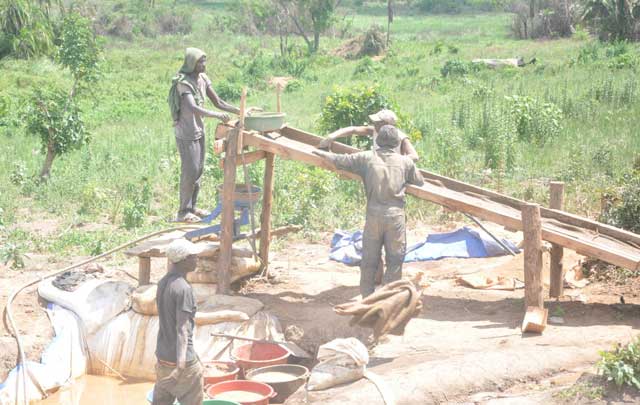
Mubende, Uganda | THE INDEPENDENT | Although the terrain of Artisanal and Small Scale Mining-ASM in Uganda is promising with several developments and most remarkably the policy shift, several actors including miners and civil society organizations paint a faint picture for the future.
A smile has returned on the face of artisanal miners in Mubende-Kassannda areas while their counterparts in Buhweju are still crying foul following their eviction. Many other miners in Wakiso quarries are busy extracting stone aggregates but seem ignorant of what is going on in the sector.
This depicts the uncertainty status and the changing face of artisanal and small scale mining in the country, which is believed to be the backbone of the extractive sector producing an estimated 90 percent minerals, ranging from Gold, tin, and tungsten.
Alex Luggya, an artisanal miner in Mubende, stresses that currently everybody is seemingly witch-hunting ASMs and many of their friends have since lost their livelihood and lives in worst cases as they fight to have their plight heard.
“Everything was in silence and nobody seemed to be caring about the existence of artisanal until the Mubende gold rush happened. From them, we are hearing artisanal in different areas, extracting different minerals all being disturbed by authorities,” said Luggya.
John Bosco Bukya, the Chairperson of Uganda Artisanal and Small-Scale Miners’ Association, says despite the emphasis government is placing on industrial mine development by foreign investors whom according to him are just speculators, a significant share of Uganda’s mineral production and related sources of employment are widely attributed ASM. Adding that, once given chance and supported, they can turn around the sector.
Dr. Don Bwesigye Binyina, the Executive Director Africa Centre for Energy and Mineral Policy, stresses that although artisanal mining is directly and indirectly, supporting millions of Ugandans it is still transitioning along the resiliency pathway.
In the recent years, government through the Energy and Mineral Development Ministry has prioritized formalization of Artisanal and Small-scale Mining thus fast-tracking several initiatives including registration and formulation of associations of artisanal miners and revision of the existing legislation.
Eng. Vincent Kedi, the Principal Engineer for Mining in the Department of Geological Survey, says the introduction of a fresh legal regime is underway having passed the new mining regulations and embarking on enacting a new Act envisioning new Licensing Schemes for artisanal and Small scale mining by clearly defining them and their operations to offer solutions to vast challenges.
“Like it or not ASMs are key in the mining sector. However, the current laws do not adequately address the licensing regime for ASM, commercial exploitation of some mineral commodities such as sand, clay, stones, murrum, and gravel, among other things. With the new legal regime, we expect to address such challenges and in the end, we will streamline the sector,” says Eng. Kedi.
Recently, government also approved the Mining and Mineral Policy which among other things commits to establish an ASM Fund to support lending schemes and acquisition of licenses for artisanal miners. Dr. Binyina notes that with the policy shift, they have faith that if the government walks the talk on empowering ASMs by allowing them to co-exist with foreign investors, availing capacity building and ensuring financial support, the sector will take off to greater heights.
However, Emmanuel Kibirige, the General Secretary of Mubende United Miner Association observes that the draft bill cannot be the lasting solution to the numerous challenges faced by ASMs in Uganda.
To Bukya there is light at the end of the tunnel given the move to legalize their activities, saying he thinks that the move will see them achieve more and uplift the sector.
Bukya however, adds that even when ASMs have been allowed to officially operate, the conditions remain unfavorable citing the short term license issued to them. He says the said licenses expire before one has done anything and asked government to consider raising the number of years from two to at least 20 years in case of small scale miners and five for artisanal miners.
In Buhweju artisanal miners remain uncertain of the future as long as government doesn’t reconsider the idea of having security organs directly involved in the mining sector. Savino Gumisiriza says the police mineral protection unit gives them a hard time through extortion.
In the same development, although building materials are considered as minerals and their extraction regulated, many people working in these places are unaware of the ongoing arrangements.
Rogers Ntale, a miner of stone aggregates in Mende in Wakiso District, says they don’t know what is going on. “We have heard over the radio about a move to regulate our work but nobody has come to explain us anything,” he said.
Dr. Binyina notes that this predicts doom since the building minerals as they ought to be called in the proposed bill are very important than metallic minerals. He adds that the sand, stone aggregates and clay among others are at the foundation of the economy and country’s development.
As Uganda’s mining sector regains momentum by attracting more foreign investors, the lingering question now is on the fate and plight of artisanal and small scale miners whose livelihoods are under threat.
*******
URN
 The Independent Uganda: You get the Truth we Pay the Price
The Independent Uganda: You get the Truth we Pay the Price


